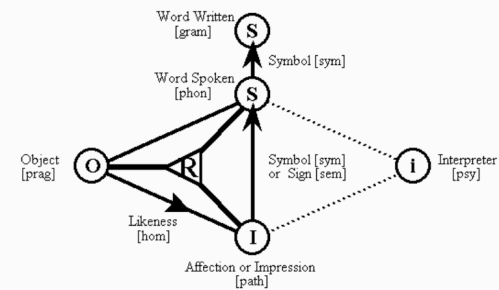Re: FB | Medieval Logic • Edward Buckner (1) (2)
Edward Buckner raised a few questions about the sign relations implicit in Aristotle’s treatise “On Interpretation”, prompting the following thoughts on my part.
On Pragmata
The object of a sign is any object of discussion or thought. It is relational not ontological. This is the beginning of pragmatic semiotics.
On Homoiomata
The likeness theory of reference has the same problem as the correspondence theory of truth, namely, the concepts of likeness and correspondence used in those theories both refer to dyadic relations and dyadic relations are not adequate to the task of accounting for the complex of activities composing the intellect, for example, inquiry, learning, reasoning, speech, thought, in short, Information Development/Exchange Activities.
In actuality, Aristotle comes closer to recognizing the triadic relation of Objects, Signs, and Ideas than the majority of later writers before Peirce. Here is the figure Susan Awbrey and I cut in our first hack at the matter.
Figure 1. The Sign Relation in Aristotle
Resources
- Awbrey, J.L., and Awbrey, S.M. (1995), “Interpretation as Action : The Risk of Inquiry”, Inquiry : Critical Thinking Across the Disciplines 15(1), 40–52. Archive. Journal. Online.
- πρᾶγμα • Liddell, H.G., and Scott, R. (1925), A Greek-English Lexicon (1940 edition),
Perseus Digital Library. - Survey of Pragmatic Semiotic Information
- Survey of Semiotics, Semiosis, Sign Relations
cc: Category Theory • Cybernetics (1) (2) • Ontolog Forum • Peirce List (1) (2) (3) (4)
cc: FB | Semeiotics • Laws of Form • Structural Modeling • Systems Science


Pingback: Survey of Semiotics, Semiosis, Sign Relations • 1 | Inquiry Into Inquiry
Pingback: Survey of Semiotics, Semiosis, Sign Relations • 2 | Inquiry Into Inquiry
Pingback: Survey of Semiotics, Semiosis, Sign Relations • 3 | Inquiry Into Inquiry
Pingback: Survey of Semiotics, Semiosis, Sign Relations • 4 | Inquiry Into Inquiry
Pingback: Survey of Semiotics, Semiosis, Sign Relations • 5 | Inquiry Into Inquiry